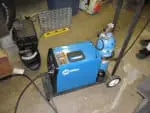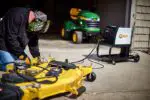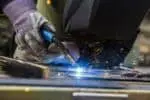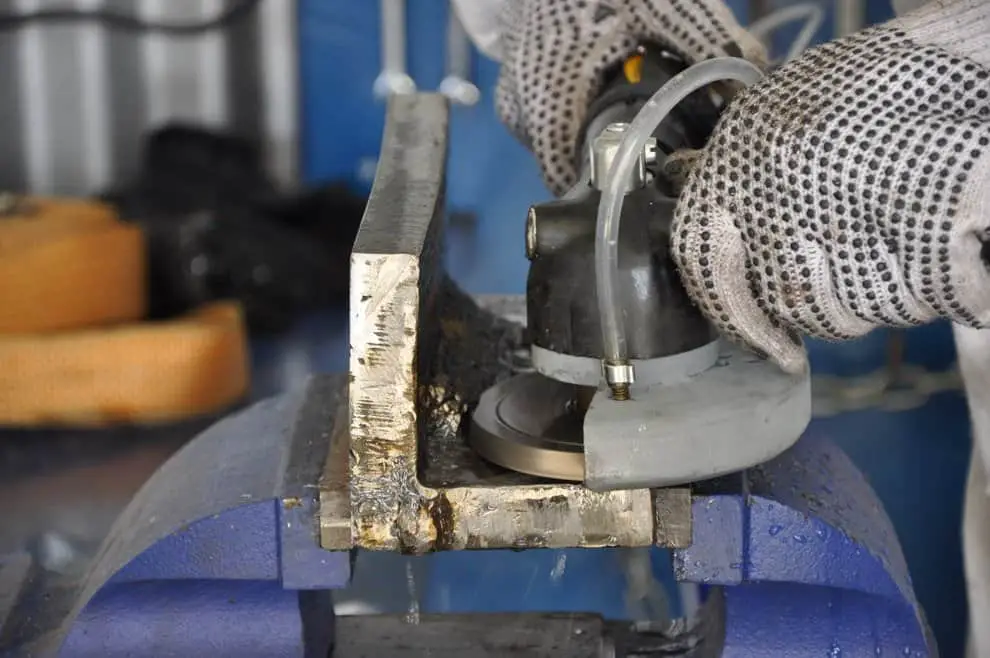 If you MIG weld, you are familiar with the process of welding metals together with the assistance of electricity. However, just as it is important to know how to weld your projects, it is equally important to know how to undo or remove a MIG weld.
If you MIG weld, you are familiar with the process of welding metals together with the assistance of electricity. However, just as it is important to know how to weld your projects, it is equally important to know how to undo or remove a MIG weld.
This is an important part of welding, and you may need to remove a weld for any number of reasons. it could be due to error, just as it may be necessary to recycle materials from old projects to be used in new ones.
How does one remove a weld? That will depend on a number of factors, and as each type of welding has different procedures, there will be different requirements for undoing or removing a weld.
The most common procedures used for removing a weld include:
-
-
- Plasma cutting
- Torch cutting
- Grinding or circular saws
- Oxy-acetylene torches
-
1. Removing a Weld Mechanically
When opting for mechanical removal of a weld, you will cut the weld manually. Several methods exist for the mechanical removal, but much will depend on the type of weld performed. In some cases, it will be impossible to remove a weld without damaging the base metals.
Mechanical removal employs cutting, drilling, or grinding. An example might be metal sheets that are spot-welded together. This removal will require you to drill directly into the metal sheets.
Grinder or circular saw removal. Often, after welding, a bead will need to be ground down with a grinder for angles. While these machines are often used surface preparation for the creation of beveled edges, they also cut.
Grinder cuts will not be as precise as cuts performed with plasma cutters, they are less expensive and do not radiate as much heat meaning that base metals will not be altered by excessive heat.
To use a grinder:
-
-
- Mark the cut you wish to make with a marker
- Using clamps, fix your base metals securely.
- Connect the saw or grinder and begin to cut the metal. It is important not to push the saw, allowing it to proceed gradually in order to avoid breaking the cutting disc.
- When you have finished, allow the base metals to cool completely. This type of cutting produces some friction heat.
-
If you wish to use a mechanical method, however, prefer not to use a grinder, you can drill to remove a weld or even use a hacksaw or band saw.
2. Removing a Weld Thermically
The word “thermal” refers to procedures that will involve heat. Using a thermal procedure for weld removal will require the use of exceptionally high temperatures to be able to remove your weld. Thermal removal is done with either a plasma cutter or by using an oxyacetylene torch.
To Undo or remove a Weld:
-
-
- Mark the cut you wish to make on the metal
- Secure the metal pieces in place with clamps to impede movement
- Connect the electricity and turn the torch on
- Check to see that the torch is connected to the compressor and turn it on.
- Move the cutting tool along the line slowly. Do not linger on one spot.
- Once the cut is completed, allow the metals to cool completely before handling them to ensure your safety.
-
Plasma Cutter Removal
A plasma cutter allows you to cut with an electrical conductor and a rapid jet of very hot plasma. Thanks to direct electrical current, an arc will be created and will reach a temperature of up to 20,000° Celsius. The generation of the heat is due to a high-pressure airflow emitted from a small-sized nozzle.
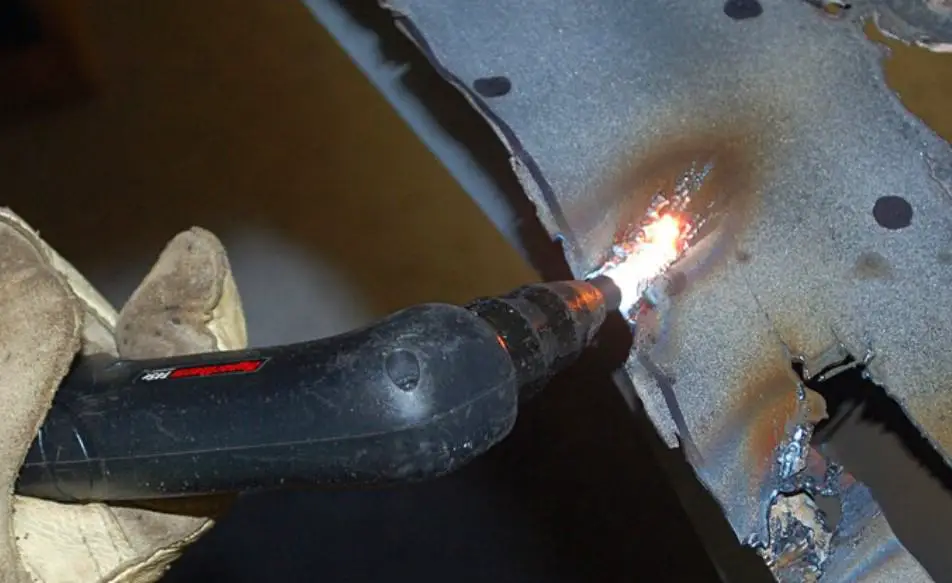
The advantages of using a plasma cutter include:
-
-
- A cutting speed that is approximately five times more rapid than a manual torch
- The ability to cut through numerous types of material and at varying thicknesses. This is very important for deep weld removal.
- They do not utilize flammable gases when cutting
- They are easy to operate
- They tend to be more economical than other types of cutting.
-
Torch Cutter Removal
An acetylene torch is another option for removing a weld. This torch will mix oxygen with acetylene to create a very hot flame. These flames can reach 3500° Celsius and this type of torch is used for both welding and weld removal.
As a beginner, this type of weld removal presents more risk to your safety. The torch will utilize a combination of two gases. The gases are mixed and then create a flame with the torch. This flame will be able to cut very thick pieces of metal due to the amount of heat it produces.
When using a torch cutter:
-
-
- Mark a line where you intend to cut.
- Turn on the torch and regulate the arc.
- Cut slowly along the line you have marked until you have completed the cut.
-
This can be a very convenient method because it is easy and not very time-consuming. The torch equipment is not very expensive and is easily transported. It can be operated on many kinds of metal.
See also: How much electricity does a MIG welder use?
3. Drilling to Remove Spot Welds
To remove spot welds, some welders prefer drilling even if you may lose or damage some of the original material. There are two types of drilling to help you remove a spot weld:
1.) Drilling with a special bit. This method uses a special spot weld drill bit that is wide, flat and has a tip that is self-centering to avoid wandering during drilling.
The only reservation about this method is that each drill bit is for a specific size of spot weld, so you may need more than one and they can be a bit expensive. They are more accurate and are fabricated to last. They also will permit you to remove a weld without damaging both pieces of material.
2.) Using a standard drill. With this method, you just need a drill and a set of bits. This procedure will require more time but no special tools. It may also consume your bits relatively quickly.
This method will not permit you to save both of your metals because you will need to drill through. You also will not be able to do many spot welds because your bit will dull. You can begin with a smaller hole and then introduce a larger bit to remove the weld, but it will be more time-consuming.
Why you Need to Remove Weld Joints
Through welding, a strong bond is created to join two metals together. Most often the joint will actually be stronger than the two metals that have been joined. As a result, the joint or weld will be more difficult to break than a single piece of metal.
If you are a beginner welder, it is natural for mistakes to be made. To correct your mistakes, in all probability you will need to remove the weld. Rather than just using blunt force, there are several techniques that can be applied to remove or undo your weld.
Things to Consider While Removing Weld
Much will depend on what type of weld you need to undo. When considering the removal of welds, you will also have to decide whether to remove them thermally or mechanically.
To select the appropriate removal procedure, consider which base metal is involved. If the welds are particularly strong or you wish to remove a weld of two sheets joined together, it may be better to grind or drill to open the weld.
Know that sometimes a weld removal can result in one of the joined pieces being damaged. This may happen due to the filler metal. You can repair this by filing or grinding.
If you cut the weld and wish to reuse the materials, you will need to grind the existing bead down so that you can do a new bead. It is better not to attempt to weld metals again unless you have removed any excess material from the original weld.
FAQ
How do I “unweld” a weld?
There are several procedures and techniques for removing a weld and separating metals. These include both mechanical or thermal removal procedures.
Why did my weld turn out badly?
A common cause is the contamination of the weld because of contact with the air. This will cause a weld to be porous and may cause the weld to crack. It could also be a bad welding technique due to a lack of experience.
How do I know if my weld is bad?
Different types of welding have different indications. Some signs of an under-par weld include:
-
-
- Cracking
- Spatter
- Lack of uniformity
- Porosity
- Overlap
- Welding lines that are thin
- Undercutting or a groove that develops at the base of the metal
-
Can I remove a tack weld?
Yes, with either a grinder or a plasma cutter.
Can I drill my MIG weld?
Yes, with stainless steel drill bits.
Is it difficult to drill a MIG weld?
If you have welding mild steel and using mild wire filler, you should be able to with any problems, particularly if the weld has good penetration. If the weld contains a pocket of air, your drill may move when you begin.
Instead of removal, can I weld over a weld?
This practice is actually more common than one might think. However, there are some concerns when welding over a weld. The cooling rates and even heat inputs of the two welds’ metals can create problems. A difference in metal composition can also be a problem.
Conclusion
It is natural to make mistakes, and especially for beginner welders, this should be expected. At the same time, for the success of your project, you will need to remove welds to correct a joint.
It is just as important for you to know how to remove and to practice removing welds as is the welding process itself. And this ability will also permit you to recycle or find new uses for previously used materials.
While there are several methods for removing welds, an angle grinder is an ideal option for smaller projects and a plasma cutter is rapid and precise for undoing any weld.
Even if you are unhappy that you did not get the perfect weld the first time, better to remove the weld than discard an entire project especially if you are close to the finish line. Welding is truly an amazing art and undoing welds correctly is an important part.



